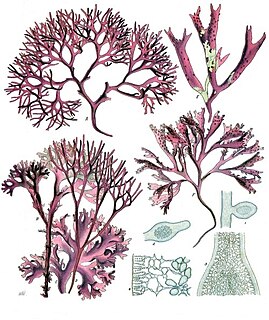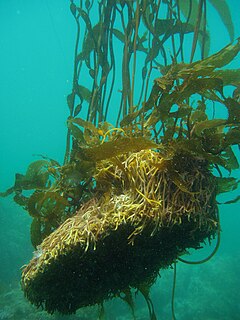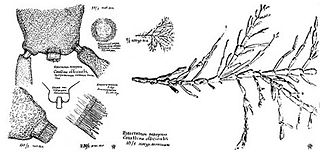
Algae is an informal term for a large, diverse group of photosynthetic eukaryotic organisms that are not necessarily closely related, and is thus polyphyletic. Including organisms ranging from unicellular microalgae genera, such as Chlorella and the diatoms, to multicellular forms, such as the giant kelp, a large brown alga which may grow up to 50 m in length. Most are aquatic and autotrophic and lack many of the distinct cell and tissue types, such as stomata, xylem, and phloem, which are found in land plants. The largest and most complex marine algae are called seaweeds, while the most complex freshwater forms are the Charophyta, a division of green algae which includes, for example, Spirogyra and the stoneworts.

Nori (海苔) is the Japanese name for edible seaweed species of the red algae genus Pyropia, including P. yezoensis and P. tenera. It has a strong and distinctive flavor. It is used chiefly in Japanese cuisine as an ingredient to wrap rolls of sushi or onigiri, in which case the term refers to the dried sheets.

Chondrus crispus—commonly called Irish moss or carrageen moss —is a species of red algae which grows abundantly along the rocky parts of the Atlantic coast of Europe and North America. In its fresh condition this protist is soft and cartilaginous, varying in color from a greenish-yellow, through red, to a dark purple or purplish-brown. The principal constituent is a mucilaginous body, made of the polysaccharide carrageenan, which constitutes 55% of its dry weight. The organism also consists of nearly 10% dry weight protein and about 15% dry weight mineral matter, and is rich in iodine and sulfur. When softened in water it has a sea-like odour and because of the abundant cell wall polysaccharides it will form a jelly when boiled, containing from 20 to 100 times its weight of water.

Phycology is the scientific study of algae. Also known as algology, phycology is a branch of life science and often is regarded as a subdiscipline of botany.

A holdfast is a root-like structure that anchors aquatic sessile organisms, such as seaweed, other sessile algae, stalked crinoids, benthic cnidarians, and sponges, to the substrate.

Sargassum is a genus of brown macroalgae (seaweed) in the order Fucales. Numerous species are distributed throughout the temperate and tropical oceans of the world, where they generally inhabit shallow water and coral reefs, and the genus is widely known for its planktonic (free-floating) species. Most species within the class Phaeophyceae are predominantly cold-water organisms that benefit from nutrients upwelling, but the genus Sargassum appears to be an exception. Any number of the normally benthic species may take on a planktonic, often pelagic existence after being removed from reefs during rough weather; however, two species have become holopelagic—reproducing vegetatively and never attaching to the seafloor during their lifecycles. The Atlantic Ocean's Sargasso Sea was named after the algae, as it hosts a large amount of Sargassum.

Fucus is a genus of brown algae found in the intertidal zones of rocky seashores almost throughout the world.

Fucus serratus is a seaweed of the north Atlantic Ocean, known as toothed wrack or serrated wrack.

Ceramium is a genus of red algae. It is a large genus with at least 15 species in the British Isles.

The Fucales (fucoids) are an order in the brown algae. The list of families in the Fucales, as well as additional taxonomic information on algae, is publicly accessible at Algaebase.

AlgaeBase is a global species database of information on all groups of algae, as well as one group of flowering plants, the sea-grasses.
The history of phycology is the history of the scientific study of algae. Human interest in plants as food goes back into the origins of the species and knowledge of algae can be traced back more than two thousand years. However, only in the last three hundred years has that knowledge evolved into a rapidly developing science.

Corallina officinalis is a calcareous red seaweed which grows in the lower and mid-littoral zones on rocky shores.

Polysiphonia is a genus of filamentous red algae with about 19 species on the coasts of the British Isles and about 200 species worldwide, including Crete in Greece, Antarctica and Greenland. Its members are known by a number of common names. It is in the order Ceramiales and family Rhodomelaceae.

Saccharina latissima is a brown algae, of the family Laminariaceae. It is known by the common name sugar kelp, and also sea belt and Devil's apron, due to its shape. It is found in the north east Atlantic Ocean, the Pacific Ocean and the Barents Sea south to Galicia in Spain. It is not found in the Bay of Biscay but is common round the coasts of the British Isles. The species is found at sheltered rocky seabeds.

Isabella Aiona Abbott was an educator and ethnobotanist from Hawaii.
The first native Hawaiian woman to receive a PhD in science,
she became the leading expert on Pacific algae.

Macrocystis pyrifera, commonly known as giant kelp or giant bladder kelp, is a species of kelp, and one of four species in the genus Macrocystis. Giant kelp is common along the coast of the eastern Pacific Ocean, from Baja California north to southeast Alaska, and is also found in the southern oceans near South America, South Africa, Australia, and New Zealand. Individual algae may grow to more than 45 metres long at a rate of as much as 60 cm (2 ft) per day. Giant kelp grows in dense stands known as kelp forests, which are home to many marine animals that depend on the algae for food or shelter. The primary commercial product obtained from giant kelp is alginate, but humans also harvest this species on a limited basis for use directly as food, as it is rich in iodine, potassium, and other minerals. It can be used in cooking in many of the ways other sea vegetables are used, and particularly serves to add flavor to bean dishes.

Ceramium ciliatum is a small marine red alga in the Division Rhodophyta.

















